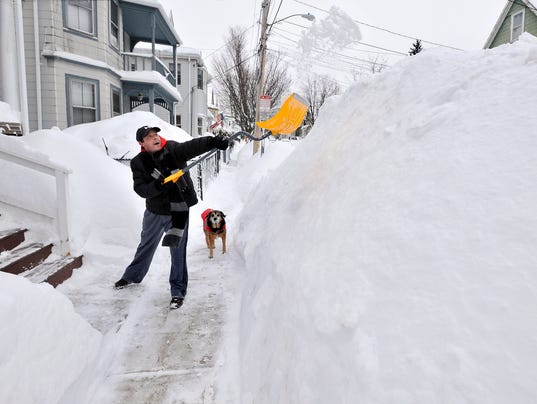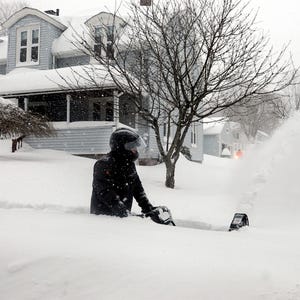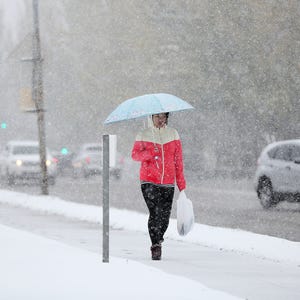Record Siberian snow could bode ill for Northeast
Thomas M. Kostigen, Special for USA TODAY 6:06 a.m. EST November 7, 2015

(Photo: Josh Reynolds, AP)
There is a theory about snow in Siberia during the month of October: If there is a lot, it can mean a particularly wicked winter in the northeast United States.
Last month, Siberia experienced record snowfall and the worst blizzard in a decade.
Above-average snow cover in Siberia is believed to affect the now-famous polar vortex and send bitterly cold temperatures to the Northeast. This happens when the Arctic Oscillation, a climate pattern, shifts.

When its winds are strong, the Arctic Oscillation keeps a tight hold on temperatures swirling around the North Pole. When it becomes weakened, or what meteorologists call “negative,” it allows arctic air masses to creep into the mid-latitudes.
The National Oceanic and Atmospheric Administration (NOAA) describes it this way: “Air pressure is higher than average over the arctic and lower than average over the mid-latitudes. The jet stream shifts southward of its average latitude.” That steers frigid, polar air southward into North America.
Above-average Siberian snow cover points to a negative oscillation pattern. But not always. And it is especially not certain that will happen this winter. Myriad factors, not the least of which is the strong El Niño being experienced globally, come into play.

Atmospheric and Environmental Research scientist Judah Cohen, who tracks the Arctic Oscillation and its correlation to U.S winters, wrote on his blog: “It is challenging to anticipate how the final outcome of competing forcings from the tropics and the high latitudes will influence mid-latitude weather.”
He explains that while October snow cover was above normal in Siberia this year, it did not advance as much as the previous two Octobers. Moreover, Arctic sea ice extent remains below normal. Cohen is expecting important pattern changes this month will provide better clues to the winter ahead.
At the moment and for the short-term, he is forecasting a mild pattern. Still, it’s worth checking Arctic Oscillation reports (the Climate Prediction Center provides 14-day forecasts) and taking steps to prepare for the worst.
Here are some things you can do:
• Stack up on wood for your fireplace, ready space heaters and store extra heating fuel. (Always store fuel in a well-ventilated place.)
• Keep winter clothing and extra blankets handy.
• Insulate walls and attics. Weather strip windows and doors. Consider installing storm windows.
• Clear overhanging branches and weak trees. The extra weight of ice can break branches and topple trees.
• Know where water valves are and learn how to close them in case of pipe bursts.
• Have your roof examined to ensure it can withstand the weight of ice and snow. Just one cubic foot of snow can weigh 20 pounds.
• Make sure propane tanks and other hazardous liquids and materials are stored properly in vented areas.
• Find out where local shelters are set up ahead of time. Organizations such as the Red Cross will often provide shelters during cold months.
• Turn your thermostats to 68 degrees. This habit will help you conserve fuel during long-lasting cold spells.
Thomas M. Kostigen is the founder of TheClimateSurvivalist.com and a New York Times bestselling author and journalist. He is the National Geographic author of "Extreme Weather Survival Guide: Understand, Prepare, Survive, Recover" and the NG Kids book, "Extreme Weather: Surviving Tornadoes, Tsunamis, Hailstorms, Thundersnow, Hurricanes and More!" Follow him @weathersurvival, or email kostigen@theclimatesurvivalist.com.
Thomas M. Kostigen, Special for USA TODAY 6:06 a.m. EST November 7, 2015

(Photo: Josh Reynolds, AP)
There is a theory about snow in Siberia during the month of October: If there is a lot, it can mean a particularly wicked winter in the northeast United States.
Last month, Siberia experienced record snowfall and the worst blizzard in a decade.
Above-average snow cover in Siberia is believed to affect the now-famous polar vortex and send bitterly cold temperatures to the Northeast. This happens when the Arctic Oscillation, a climate pattern, shifts.

When its winds are strong, the Arctic Oscillation keeps a tight hold on temperatures swirling around the North Pole. When it becomes weakened, or what meteorologists call “negative,” it allows arctic air masses to creep into the mid-latitudes.
The National Oceanic and Atmospheric Administration (NOAA) describes it this way: “Air pressure is higher than average over the arctic and lower than average over the mid-latitudes. The jet stream shifts southward of its average latitude.” That steers frigid, polar air southward into North America.
Above-average Siberian snow cover points to a negative oscillation pattern. But not always. And it is especially not certain that will happen this winter. Myriad factors, not the least of which is the strong El Niño being experienced globally, come into play.

Atmospheric and Environmental Research scientist Judah Cohen, who tracks the Arctic Oscillation and its correlation to U.S winters, wrote on his blog: “It is challenging to anticipate how the final outcome of competing forcings from the tropics and the high latitudes will influence mid-latitude weather.”
He explains that while October snow cover was above normal in Siberia this year, it did not advance as much as the previous two Octobers. Moreover, Arctic sea ice extent remains below normal. Cohen is expecting important pattern changes this month will provide better clues to the winter ahead.
At the moment and for the short-term, he is forecasting a mild pattern. Still, it’s worth checking Arctic Oscillation reports (the Climate Prediction Center provides 14-day forecasts) and taking steps to prepare for the worst.
Here are some things you can do:
• Stack up on wood for your fireplace, ready space heaters and store extra heating fuel. (Always store fuel in a well-ventilated place.)
• Keep winter clothing and extra blankets handy.
• Insulate walls and attics. Weather strip windows and doors. Consider installing storm windows.
• Clear overhanging branches and weak trees. The extra weight of ice can break branches and topple trees.
• Know where water valves are and learn how to close them in case of pipe bursts.
• Have your roof examined to ensure it can withstand the weight of ice and snow. Just one cubic foot of snow can weigh 20 pounds.
• Make sure propane tanks and other hazardous liquids and materials are stored properly in vented areas.
• Find out where local shelters are set up ahead of time. Organizations such as the Red Cross will often provide shelters during cold months.
• Turn your thermostats to 68 degrees. This habit will help you conserve fuel during long-lasting cold spells.
Thomas M. Kostigen is the founder of TheClimateSurvivalist.com and a New York Times bestselling author and journalist. He is the National Geographic author of "Extreme Weather Survival Guide: Understand, Prepare, Survive, Recover" and the NG Kids book, "Extreme Weather: Surviving Tornadoes, Tsunamis, Hailstorms, Thundersnow, Hurricanes and More!" Follow him @weathersurvival, or email kostigen@theclimatesurvivalist.com.




» Parliamentary regions: Article 140 road is closed
» The Central Bank of Iraq's dollar sales increased
» Al-Alaq reviews to the President of the Republic the Central Bank’s plans to develop the banking sec
» Al-Atwani to the French Embassy delegation: Halting external borrowing indicates an improvement in I
» Parliamentary move against Kar Oil Company: Suspicions of "fake" electricity supply
» Parliamentary Health: Iraq suffers from a large surplus in the number of doctors and pharmacists by
» It causes a loss of one billion dollars per month.. A date has been set for the resumption of Kurdis
» Türkiye blames Iraq: You waste water and do not have good management in rationalizing it
» Iraq rejects “COP29” proposal: We will not get rid of fossil fuels, as they are the basis of our eco
» Bitcoin nears $90,000 after biggest drop since election
» For the first time, Iraq issues the commodity structure of exports and imports
» Procedures for (automating) the work of Baghdad International Airport
» Planning: No cuts to benefits or taxes due to census
» International organizations praise the government's national initiatives
» {Official platform} to combat rumors
» Al-Sudani: The census will be used exclusively to develop development plans
» Justice audits financial movements in its departments
» Al-Imar to {Sabah}: 3 residential cities in Baghdad to be referred soon
» Kurdistan Region of Iraq plans to receive 10 million tourists annually
» Discussion of mineral investment and export mechanisms
» Consensus on the importance of planning in achieving sustainable development
» Corporate Restructuring: Stimulating Economic Growth
» Iraq's commitment to OPEC decisions controls oil prices
» Delete zeros and evaluate the dinar
» Economists: Empowering the private sector requires a legislative system
» Preparations for holding meetings of the Iraqi-Egyptian Committee
» Parliamentary Legal Committee to Nina: Controversial and important laws will be passed in one go in
» Central Agency for Public Mobilization and Statistics to Nina: The census activities are completely
» Turkish Trade Minister to visit Iraq tomorrow, Monday, heading a delegation of businessmen
» Slight decrease in dollar exchange rates in local markets
» Basra Gas Company launches the “Safe Step” program to raise awareness of the dangers of mines and wa
» With high-level governmental and international presence... the activities of the Iraqi Digital Space
» Ministry of Oil: FCC project to produce derivatives to be completed in the middle of next year
» Does America influence the decisions to form the regional government?.. 5 critical months
» Search for remains of the eight-year war postponed until 2025.. Diggers await spring
» US forces reposition in the "Desert Triangle" in western Iraq
» Al-Dahlaki: The general amnesty law is not just an election slogan as the "forgers" want it to be
» Date set for resuming oil exports from Kurdistan via Turkish port of Ceyhan
» 2025 budget between the government and parliament corridors
» Parliamentary Finance: Population census is a criterion for distributing resources and financial all
» Dollar prices in Iraqi markets
» A source reviews the factors that "undermine" the goals.. What is behind the efforts to form the "Ce
» What are the most controversial paragraphs in the general amnesty law? Al-Saadi reveals to Sumaria
» MM&C 11/17/24 For the first time in Iraq.. Efforts to establish an "Investment Association" to attr
» Al-Sudani chairs the fifth session of the Supreme Coordination Committee between the governorates
» A fruitful international-Japanese partnership produces its eighth batch... Celebrating the success o
» The President of the Republic stresses the need to develop a future strategy for financial policy ac
» Tomorrow.. Turkish Trade Minister visits Baghdad to discuss several files
» Rashid and Al-Alaq discuss the future of the Iraqi banking sector
» US Ambassador assures Maliki of her country's support for Iraq's stability
» Parliamentarian addressing the Judicial Council: When will corruption files be resolved?
» Economist: Re-exporting Kurdistan oil will cause Iraq to lose $5 billion and a budget deficit
» Financial Advisor: Good performance of fiscal space reflects government’s ability to increase spendi
» The President of the Republic stresses the need to develop a future strategy for financial policy
» Parliament determines the most important laws it will work on before its legislative break in a few
» Dollar exchange rates against the dinar in Iraqi stock exchanges
» Government correspondence to install 8 thousand electricity meter readers
» utube 11/16/24 MM&C-News Report-Iraq Dinar-Oil-Flow-Global Maritime Trade-Cross Border Transfer-Ex
» utube 11/13/24 MM&C MM&C News-Private Sector- Electronic Payments-Reconstruction-Development-Digit
» utube MM&C 11/15/24 Update-Budget-Non Oil Resources-CBI-USFED-Cross Border Transfers-Oil
» Al-Sudani is besieged by lawsuits over the “wiretapping network”... and Al-Maliki heard “inappropria
» Tens of thousands of foreigners work illegally in Basra... and the departments will bear the respons
» 4 reasons for the Sudanese government’s silence in the face of the factions’ attacks.. Will Baghdad
» PM's advisor: Government able to increase spending without inflation or fiscal deficit
» Prime Minister stresses the need to complete 2024 projects before the end
» Minister of Labor sets date for launching second batch of social protection beneficiaries in the pol
» Al-Sudani approves 35 new service projects, stresses the need to complete 2024 projects
» Minister of Labor: The population census will provide accurate calculations of poor families covered
» Electricity announces its readiness for the winter peak
» Economist: Parallel market remains pivotal to financing Iraq’s trade with Iran, Syria
» Trump: Iraq: A subsidiary or the focus of major deals?
» Counselor Mazhar Saleh: The government is able to increase spending without causing inflation or a f
» Al-Sudani's advisor to "Al-Maalouma": We do not need to bring in foreign workers
» Parliamentary Rejection.. Parliamentarian Talks About Jordanian Agreement That Harms Iraq’s Economy
» Al-Sudani chairs the periodic meeting of the service and engineering effort team
» Al-Sahaf: Washington continues to support terrorist organizations in Iraq
» Al-Maliki Coalition: America is trying to make Iraq hostile to its neighbors by violating its airspa
» Close source: Al-Sudani failed to convince Al-Hakim and Al-Amiri to carry out the ministerial reshuf
» Al-Sayhoud on Postponing Parliament Sessions: Bad Start for Al-Mashhadani
» Peshmerga Minister: The survival of the Kurdistan Region depends on the presence of a strong Peshmer
» Al-Maliki Coalition: US pressures prevent Israel from striking Iraq
» Nechirvan Barzani calls for keeping Peshmerga out of partisan conflicts, urges formation of 'strong
» US Institute: Trump administration may prevent Iraq from importing Iranian gas as part of pressure o
» The meter will visit families again.. Planning details the steps for conducting the population censu
» Government clarification: Is Iraq able to increase spending?
» Iraq advances over China.. Iran's trade exchange witnesses growth during October
» Al-Sudani approves 35 new service projects and begins implementing them within 10 days
» Al-Sudani and Al-Hakim discuss developments in the political scene and the results of the visit to K
» Minister of Labor: Government measures contributed to reducing the poverty rate from 22% to 16.5%
» Al-Maliki calls for strengthening national dialogue and unity to overcome the current stage
» Al-Sudani stresses the importance of accuracy and specifications in service and engineering projects
» Baghdad Governor: 169 projects are listed for referral and contracting
» Industry confirms success by signing 4 investment contracts for strategic industries
» Parliament confirms its support for conducting the general population census and decides to resume s
» Parliament gains a "holiday and a half"... Half of the "extended" legislative term passes without se
» Find out the exchange rates of the dollar against the dinar in the Iraqi stock exchanges
» Al-Maliki describes tribes as a "pillar" for confronting challenges in Iraq
» The plan in the "distribution method".. A representative describes the "investment achievement" as n